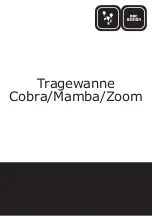
3
LTC1736
ELECTRICAL CHARACTERISTICS
The
●
denotes specifications which apply over the full operating
temperature range, otherwise specifications are at T
A
= 25
°
C. V
IN
= 15V, V
RUN/SS
= 5V unless otherwise noted.
Note 1: Absolute Maximum Ratings are those values beyond which the life
of a device may be impaired.
Note 2: T
J
is calculated from the ambient temperature T
A
and power
dissipation P
D
according to the following formulas:
LTC1736CG, LTC1736IG: T
J
= T
A
+ (P
D
• 110
°
C/W)
Note 3: The LTC1736 is tested in a feedback loop that servos V
FB
to the
balance point for the error amplifier (V
ITH
= 1.2V).
Note 4: Dynamic supply current is higher due to the gate charge being
delivered at the switching frequency. See Applications Information.
Note 5: Oscillator frequency is tested by measuring the C
OSC
charge
current (I
OSC
) and applying the formula:
Note 6: With all five VID inputs floating (or tied to VIDV
CC
) the VIDV
CC
current is typically < 1
µ
A. However, the VIDV
CC
current will rise and be
approximately equal to the number of grounded VID input pins times
(VIDV
CC
– 0.6V)/40k. (See the Applications Information section for more
detail.)
Note 7: Each built-in pull-up resistor attached to the VID inputs also has a
series diode to allow input voltages higher than the VIDV
CC
supply without
damage or clamping. (See the Applications Information section for more
detail.)
Note 8: The minimum on-time condition corresponds to the on inductor
peak-to-peak ripple current
≥
40% of I
MAX
(see minimum on-time
considerations in the Applications Information section).
Note 9: Rise and fall times are measured using 10% and 90% levels. Delay
times are measured using 50% levels.
f
C
pF
I
I
OSC
OSC
CHG
DIS
=
+
+
8 477 10
11
1
1
11
1
.
(
)
(
)
–
SYMBOL
PARAMETER
CONDITIONS
MIN
TYP
MAX
UNITS
BG Transition Time:
(Note 9)
BG t
r
Rise Time
C
LOAD
= 3300pF
50
90
ns
BG t
f
Fall Time
C
LOAD
= 3300pF
40
80
ns
TG/BG T1D
Top Gate Off to Synchronous
C
LOAD
= 3300pF Each Driver
100
ns
Gate-On Delay Time
TG/BG T2D
Synchronous Gate Off to Top
C
LOAD
= 3300pF Each Driver
70
ns
Gate-On Delay Time
Internal V
CC
Regulator
V
INTVCC
Internal V
CC
Voltage
6V < V
IN
< 30V, V
EXTVCC
= 4V
5.0
5.2
5.4
V
V
LDO(INT)
Internal V
CC
Load Regulation
I
CC
= 0mA to 20mA, V
EXTVCC
= 4V
0.2
1
%
V
LDO(EXT)
EXTV
CC
Drop Voltage
I
CC
= 20mA, V
EXTVCC
= 5V
130
200
mV
V
EXTVCC
EXTV
CC
Switchover Voltage
I
CC
= 20mA, EXTV
CC
Ramping Positive
●
4.5
4.7
V
V
EXTVCC(HYS)
EXTV
CC
Hysteresis
0.2
V
Oscillator
f
OSC
Oscillator Frequency
(Note 5), C
OSC
= 43pF
265
300
335
kHz
f
H
/f
OSC
Maximum Sync Frequency Ratio
1.3
f
FCB(SYNC)
FCB Pin Threshold For Sync
Ramping Negative
0.9
1.2
V
PGOOD Output
V
PGL
PGOOD Voltage Low
I
PGOOD
= 2mA
110
200
mV
I
PGOOD
PGOOD Leakage Current
V
PGOOD
= 5V
±
1
µ
A
V
PG
PGOOD Trip Level
V
OSENSE
with Respect to Set Output Voltage
V
OSENSE
Ramping Negative
– 6.0
– 7.5
– 9.5
%
V
OSENSE
Ramping Positive
6.0
7.5
9.5
%
VID Control
VIDV
CC
VID Operating Supply Voltage
2.7
5.5
V
I
VIDVCC
VID Supply Current
(Note 6) VIDV
CC
= 3.3V
0.01
5
µ
A
R
VFB/VOSENSE
Resistance Between V
OSENSE
and V
FB
10
k
Ω
R
RATIO
Resistor Ratio Accuracy
Programmed from 0.925V to 2.00V
±
0.05
%
R
PULL-UP
VID0 to VID4 Pull-Up Resistance
(Note 7) V
DIODE
= 0.6V
40
k
Ω
V
IDT
VID Input Voltage Threshold
0.4
1.0
1.6
V
I
VIDLEAK
VID Input Leakage Current
(Note 7) VIDV
CC
< VID < 7V
0.01
±
1
µ
A
V
PULL-UP
VID Pull-Up Voltage
VIDV
CC
= 3.3V
2.8
V
VIDV
CC
= 5V
4.5
V




































